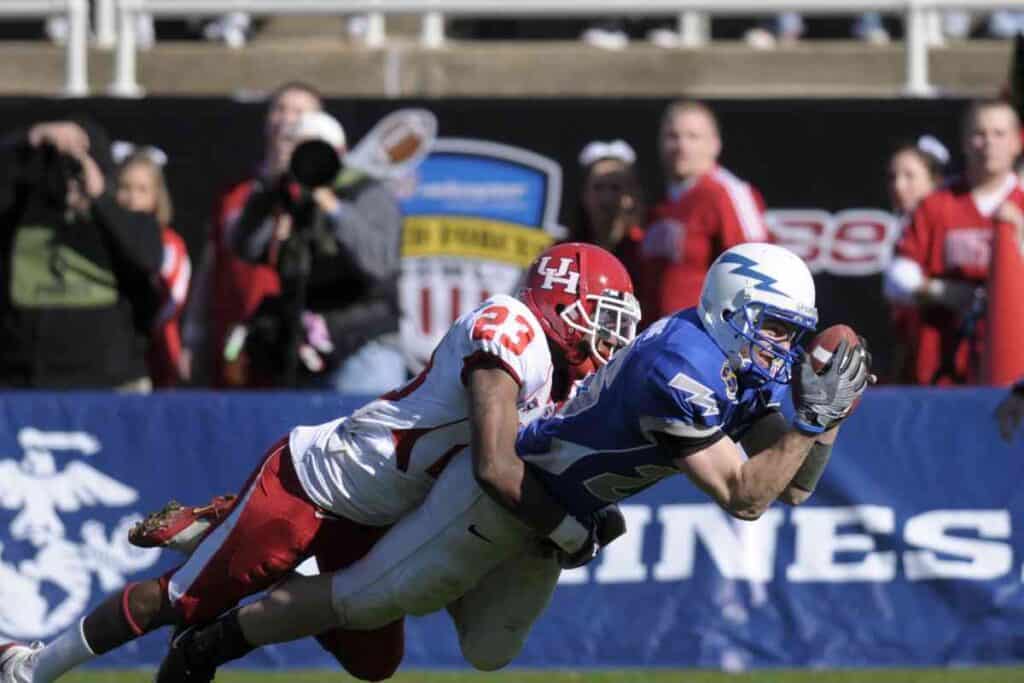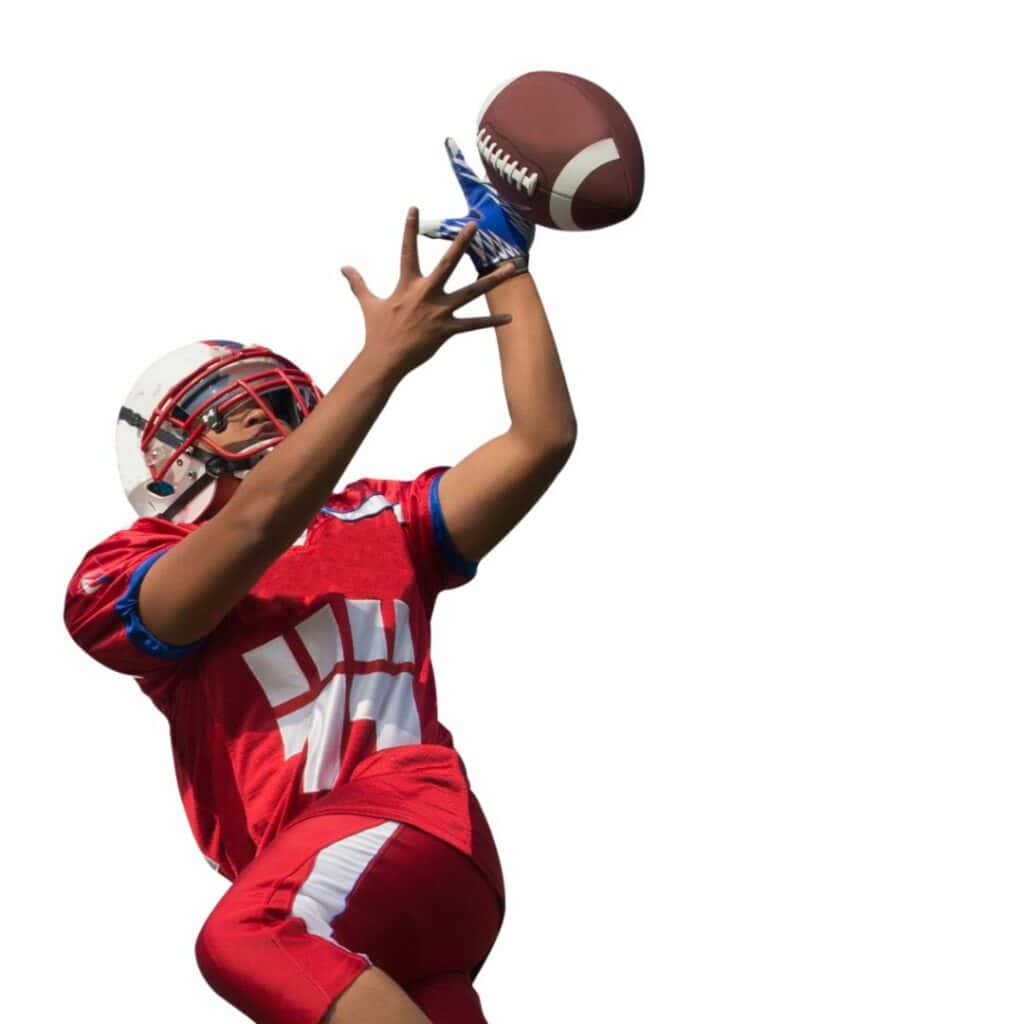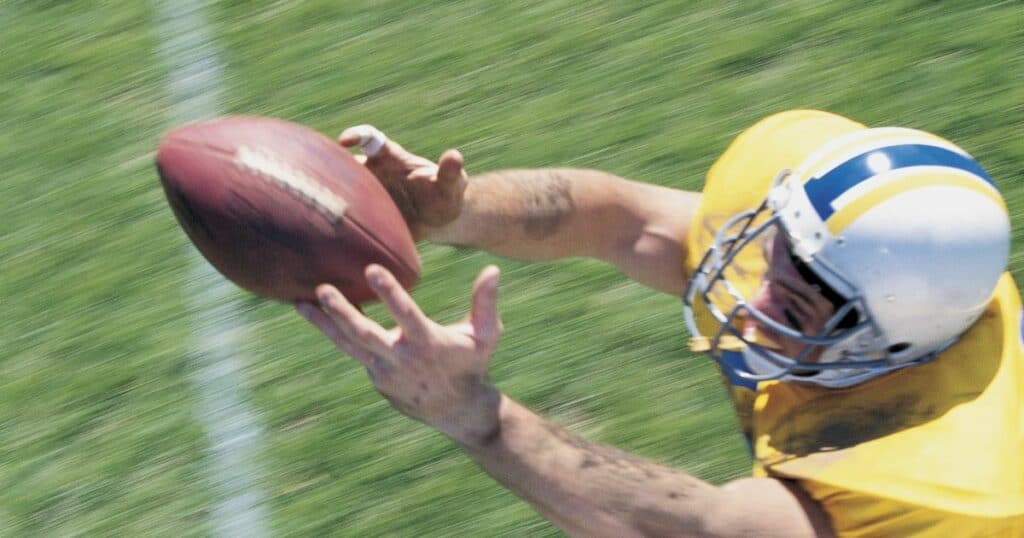What is a WR in Football: Understanding the Role of Wide Receivers on the Field

In the dynamic sport of football, wide receivers (WRs) play a crucial role in the offensive unit. In this article, we will dive into how wide receivers serve as pass-catching specialists responsible for creating space, running precise routes, and being reliable targets for quarterbacks.
By understanding the responsibilities and skills of wide receivers, we gain insight into their impact on the game and their significance to a team’s success.
Understanding the Wide Receiver Position
Role and Responsibilities
In football, the wide receiver (WR) position is responsible for catching passes from the quarterback.
The WRs are typically lined up on the outside of the offensive formation, with their main objective being to get open and catch the ball. They are often the primary targets for the quarterback on passing plays.
The role of a WR requires a combination of speed, agility, and good hands. They must be able to run precise routes, create separation from defenders, and make difficult catches in traffic.
A good WR can be a game-changer, capable of turning a short pass into a long gain or making a crucial catch in the end zone.
Different Types of Wide Receivers
There are several different types of WRs, each with their own unique skill set and responsibilities. Some of the most common types of WRs include:
- X Receiver: The X receiver is typically the team’s top WR and lines up on the line of scrimmage on the weak side of the formation. They are often the most physically gifted WR on the team, with the ability to make contested catches and break tackles.
- Y Receiver: The Y receiver, also known as the slot receiver, lines up between the offensive line and the outside WRs. They are typically smaller and quicker than the X receiver, with the ability to make quick cuts and get open in the middle of the field.
- Z Receiver: The Z receiver lines up on the strong side of the formation and is often used as a deep threat. They are typically fast and agile, with the ability to stretch the field and create big plays.
Each type of WR has a specific role to play in the offense, and it’s up to the coaching staff to determine which WRs to use in different situations.
| WR Type | Location | Characteristics |
|---|---|---|
| X Receiver | Line of scrimmage on weak side | Physically gifted, makes contested catches |
| Y Receiver | Between offensive line and outside WRs | Smaller, quicker, gets open in middle of field |
| Z Receiver | Strong side of formation | Fast, agile, stretches field |
Understanding the different types of WRs and their roles is crucial for any football team looking to succeed in the passing game.

Key Skills for a Wide Receiver
As a wide receiver, there are several key skills that you need to master in order to be successful on the field. Here are some of the most important skills that every wide receiver needs to have:
Route Running
Route running is a crucial skill for any wide receiver. You need to be able to run precise routes and create separation from defenders.
A good route runner understands how to read the defense and adjust their route accordingly. They also need to be able to change direction quickly and maintain their speed throughout the route.
| Key Points | Description |
|---|---|
| Precise Routes | Running routes with precision and accuracy |
| Separation | Creating space between the defender and the receiver |
| Adjustments | Reading the defense and adjusting the route accordingly |
| Change of Direction | Ability to change direction quickly while maintaining speed |

Catching and Blocking
Catching and blocking are two other essential skills for a wide receiver. You need to have good hands and be able to catch the ball in a variety of situations.
You must also be able to block effectively in the running game and pass protection.
| Key Points | Description |
|---|---|
| Good Hands | Ability to catch the ball in a variety of situations |
| Soft Hands | Ability to catch the ball with minimal impact |
| Focus | Maintaining focus on the ball while catching |
| Blocking | Effective blocking in both running and passing situations |
Speed and Agility
Speed and agility are also important skills for a wide receiver. You need to be able to run fast and change direction quickly in order to create separation from defenders and make big plays.
| Key Points | Description |
|---|---|
| Speed | Ability to run fast and maintain speed throughout the route |
| Agility | Ability to change direction quickly and maintain balance |
| Strength | Physical strength to break tackles and make plays |
| Focus | Maintaining focus on the ball while running |
By mastering these key skills, you can become a top-performing wide receiver and a valuable asset to your team.
The Role of Wide Receivers in Offense

Involvement in Passing Plays
Wide receivers (WRs) are essential to any offensive strategy in football. They are responsible for catching passes from the quarterback (QB) and advancing the ball down the field.
WRs are typically the primary targets for QBs during passing plays. They are trained to run routes that allow them to get open and receive the ball.
During passing plays, the QB will drop back behind the line of scrimmage and scan the field for open receivers.
The WRs will run routes that are designed to get them open and give the QB a clear target to throw to. The QB will then throw the ball to the open receiver, who will catch it and try to gain as many yards as possible.
Positioning on the Field
WRs line up on the line of scrimmage outside of the offensive line. They are usually split out wide near the sideline, but their positioning can vary depending on the formation used.
WRs can line up in various formations, including the spread offense, the pro set, and the shotgun formation.
The positioning of the WRs is critical to the success of the offense. If the WRs are too close to the line of scrimmage, they will be covered by the defense and unable to get open.
If they are too far away from the line of scrimmage, they cannot catch short passes or run short routes.
Coaches will use various techniques to ensure that the WRs are in the right position, including motion, shifts, and audibles.
These techniques can help confuse the defense and create openings for the WRs to open.
| WR Position | Description |
|---|---|
| Split End | Lines up on the line of scrimmage on the opposite side of the tight end. |
| Flanker | Lines up on the line of scrimmage on the same side as the tight end. |
| Slot Receiver | Lines up off the line of scrimmage between the split end and the offensive line. |
In conclusion, the WR position is a crucial part of any offensive strategy in football. They are responsible for catching passes from the QB and advancing the ball down the field.
Their positioning on the field is critical to their success, and coaches will use a variety of techniques to ensure that they are in the right position.

Famous Wide Receivers and Their Contributions
Historical Impact
Wide receivers have been an integral part of football since the sport’s early days.
Don Hutson is the first great wide receiver in football history, having played for the Green Bay Packers in the 1930s and 1940s.
Hutson’s contributions to the game helped establish the wide receiver position as a key component of a successful offense.
Another receiver who had a significant impact on the game was Jerry Rice. Rice is regarded as the greatest wide receiver in NFL history, having set numerous records during his career.
He won three Super Bowls with the San Francisco 49ers and was named the Super Bowl MVP in one of those victories.
Current NFL Stars
There are many talented wide receivers currently playing in the NFL.
Michael Thomas of the New Orleans Saints is one of the best in the game today, having set the single-season reception record in 2019.
Cooper Kupp of the Los Angeles Rams had a breakout season in 2021, leading the league in receptions and earning Offensive Player of the Year honors.
Justin Jefferson of the Minnesota Vikings is another rising star at the position. He set a rookie record for receiving yards in 2020 and followed it up with another impressive season in 2021.
CeeDee Lamb of the Dallas Cowboys and Davante Adams of the Green Bay Packers are also among the top wide receivers in the league.
Stefon Diggs of the Buffalo Bills, DeAndre Hopkins of the Arizona Cardinals, Allen Robinson of the Chicago Bears, and Terry McLaurin of the Washington Football Team are all talented receivers who consistently make big plays for their teams.
Calvin Johnson, who played for the Detroit Lions from 2007-2015, was one of his era’s most dominant wide receivers.
He set numerous records during his career and was named to the Pro Bowl six times.
Table of Top Wide Receivers
| Wide Receiver | Team | Career Highlights |
|---|---|---|
| Jerry Rice | San Francisco 49ers | 3x Super Bowl Champion, Super Bowl MVP, All-Time Receiving Leader |
| Don Hutson | Green Bay Packers | 2x NFL Champion, 8x First-Team All-Pro, Hall of Fame Inductee |
| Calvin Johnson | Detroit Lions | 6x Pro Bowl, 3x First-Team All-Pro, All-Time Receiving Yards Leader |
| Michael Thomas | New Orleans Saints | Single-Season Reception Record Holder, 3x Pro Bowl, 2x First-Team All-Pro |
| Cooper Kupp | Los Angeles Rams | 1x All-Pro, 2x Pro Bowl, 2021 Offensive Player of the Year |
| Justin Jefferson | Minnesota Vikings | 2x Pro Bowl, 2x All-Pro, 2020 Rookie Record for Receiving Yards |
| CeeDee Lamb | Dallas Cowboys | 1x Pro Bowl, 1x All-Pro, 2020 PFWA All-Rookie Team |
| Davante Adams | Green Bay Packers | 4x Pro Bowl, 3x All-Pro, 2020 NFL Receiving Touchdowns Leader |
| Stefon Diggs | Buffalo Bills | 1x All-Pro, 2x Pro Bowl, 2020 NFL Receiving Yards Leader |
| DeAndre Hopkins | Arizona Cardinals | 7x Pro Bowl, 4x All-Pro, 2017 Receiving Touchdowns Leader |
| Allen Robinson | Chicago Bears | 1x Pro Bowl, 1x All-Pro, 2015 PFWA All-Rookie Team |
| Terry McLaurin | Washington Football Team | 1x Pro Bowl, 1x All-Pro, 2019 PFWA All-Rookie Team |
Other notable wide receivers who have significantly contributed to the game include Terrell Owens, Randy Moss, Cris Carter, Larry Fitzgerald, Steve Largent, and Marvin Harrison.
Matthew Slater of the New England Patriots is also worth mentioning, as he has made a name for himself as one of the best special teams players in NFL history.
The Evolution of the Wide Receiver Position

From End to Wide Receiver
The wide receiver position has come a long way since its inception in the early days of football. Originally, there was only one position for pass catchers, simply called “ends.”
These players lined up on the end of the line of scrimmage and were primarily used as blockers.
However, as the forward pass became more prevalent in the game, the role of the end began to change.
In the 1930s, the end position split into two distinct positions: the tight end and the wide receiver.
The tight end was responsible for blocking and short-yardage receptions, while the wide receiver was tasked with running deeper routes and catching longer passes.
Over time, the wide receiver position became more specialized, with players focusing on speed, agility, and route-running ability.

Impact of Rule Changes
Rule changes over the years have heavily influenced the evolution of the wide receiver position.
In the 1970s, the NFL introduced new rules to protect quarterbacks and receivers, including the “Mel Blount Rule” which limited the amount of contact defenders could make with receivers downfield.
These changes opened up the passing game and allowed wide receivers to become more dominant.
Another significant rule change came in 1978 when the NFL introduced a new rule that allowed offensive linemen to extend their arms and hands to block defenders.
This change gave quarterbacks more time to throw and allowed wide receivers to run longer routes downfield.
Today, the wide receiver position is one of the most important positions on the field.
Many of the NFL’s most valuable players and all-pros are wide receivers, including Jerry Rice, Randy Moss, Calvin Johnson, and Antonio Brown.
Wide receivers are expected to be fast, agile, and possess excellent hands and route-running ability.
| All-Pro NFL Wide Receivers |
|---|
| Jerry Rice |
| Randy Moss |
| Marvin Harrison |
| Terrell Owens |
| Calvin Johnson |
| Antonio Brown |
Frequently Asked Questions
What is the role of a wide receiver in football?
A wide receiver in football is responsible for catching passes from the quarterback and sometimes running with the ball. They typically line up on the line of scrimmage outside of the offensive line and try to get open for a pass.
What is a slot receiver and how does it differ from a wide receiver in football?
A slot receiver is a type of wide receiver who lines up between the offensive line and the wide receiver on the same side of the field. They are typically smaller and quicker than outside wide receivers. The main difference between a slot receiver and a wide receiver is their position on the field and their role in the offense.
How many wide receivers are typically on the field in football?
In most offensive formations in football, there are two to three wide receivers on the field.
Do wide receivers score touchdowns in football?
Yes, wide receivers can score touchdowns in football by catching a pass in the end zone or running with the ball into the end zone.
What is the difference between a running back and a wide receiver in football?
A running back in football is responsible for carrying the ball and running with it. They typically line up behind the quarterback and receive handoffs from the quarterback. A wide receiver, on the other hand, is responsible for catching passes and sometimes running with the ball. They typically line up on the line of scrimmage outside of the offensive line.
How often do wide receivers get tackled in football?
Wide receivers in football get tackled when they catch a pass and are unable to avoid being tackled by the opposing team’s defense. The frequency with which wide receivers get tackled varies depending on the game situation and the skill of the opposing team’s defense.
